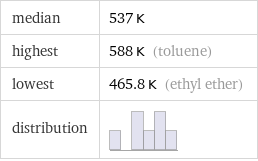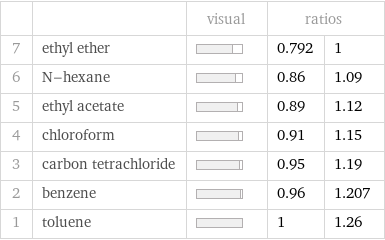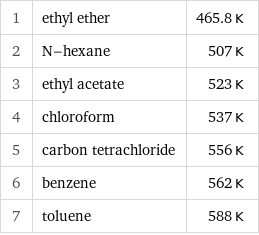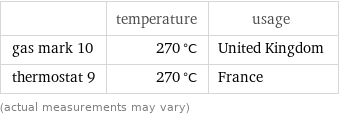Input interpretation

non-polar solvents | critical temperature
Summary

median | 537 K highest | 588 K (toluene) lowest | 465.8 K (ethyl ether) distribution |
Units

Ranked values

| | visual | ratios | 7 | ethyl ether | | 0.792 | 1 6 | N-hexane | | 0.86 | 1.09 5 | ethyl acetate | | 0.89 | 1.12 4 | chloroform | | 0.91 | 1.15 3 | carbon tetrachloride | | 0.95 | 1.19 2 | benzene | | 0.96 | 1.207 1 | toluene | | 1 | 1.26
Critical temperature rankings

1 | ethyl ether | 465.8 K 2 | N-hexane | 507 K 3 | ethyl acetate | 523 K 4 | chloroform | 537 K 5 | carbon tetrachloride | 556 K 6 | benzene | 562 K 7 | toluene | 588 K
Unit conversions for median critical temperature 537 K

264 °C (degrees Celsius)

507 °F (degrees Fahrenheit)

967 °R (degrees Rankine)

211 °Ré (degrees Réaumur)

146 °Rø (degrees Rømer)
Comparison for median critical temperature 537 K

64 K below melting point of lead (327.46 °C)

31 K above autoignition temperature of book paper in Ray Bradbury's famous novel (451 °F)

(18 to 50) K above autoignition temperature of paper (218 to 246 °C)
Corresponding quantities

Thermodynamic energy E from E = kT: | 46 meV (millielectronvolts)

Blackbody energy flux Φ from Φ = σT^4: | 4715 W/m^2 (watts per square meter)

Approximate luminous exitance from a planar blackbody radiator perpendicular to its surface: | 2.9×10^-8 lx (lux)
Nearest corresponding gas marks for median critical temperature 537 K (kelvins)

| temperature | usage gas mark 10 | 270 °C | United Kingdom thermostat 9 | 270 °C | France (actual measurements may vary)